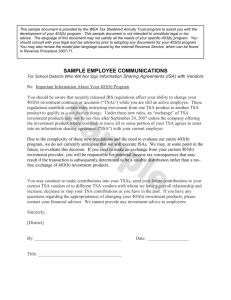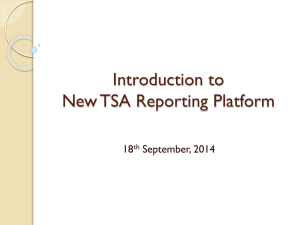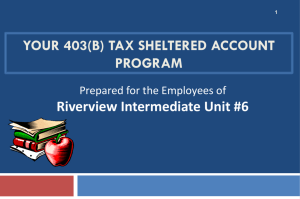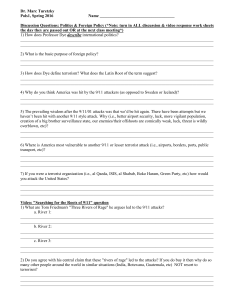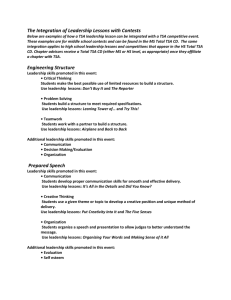A Summary of the Rose Tree Media School District’s
advertisement
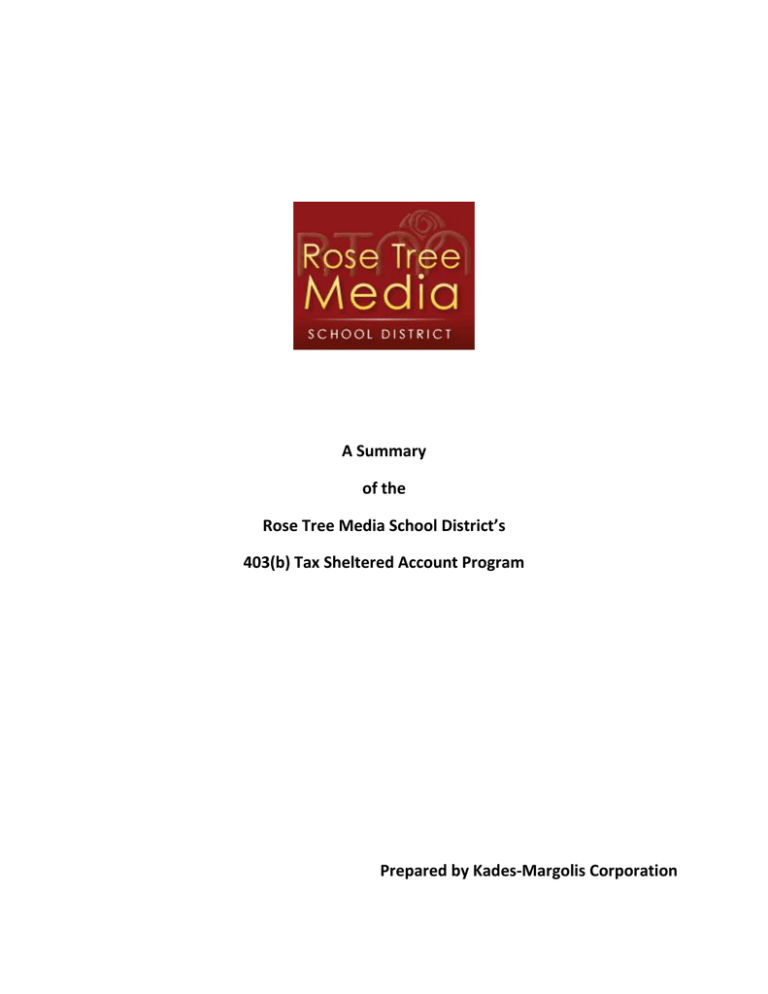
A Summary of the Rose Tree Media School District’s 403(b) Tax Sheltered Account Program Prepared by Kades-Margolis Corporation This Summary Plan Document (SPD) booklet is a brief description of the 403(b) Tax Sheltered Account (TSA) Plan and program for our school district. A copy of the complete 403(b) Plan Document is available in the Business Office. All of our school district employees, without exception, are eligible to participate in the district’s 403(b) TSA. We urge you to read this booklet and familiarize yourself with its contents so you can take advantage of a benefit that is authorized by the Internal Revenue Service and made available to you through your school district. The Internal Revenue Service permits employers to include or exclude various optional provisions in the district’s 403(b) TSA Plan Document. The list of our district’s available optional provisions is contained in APPENDIX A. What is a 403(b) Tax Sheltered Account? 403(b) is a section of the IRS Code that permits the establishment of Tax Sheltered Accounts (TSA) for school employees to supplement their retirement income. A 403(b) TSA allows you to voluntarily set aside money from each paycheck to be put into a tax-deferred account. It’s called an “elective deferral;” you notify the payroll office, by completing the Salary Reduction Agreement at the back of this SPD, that you wish (“elective”) to have funds taken out of your pay (“deferral”) and contributed to your 403(b) TSA. You may begin your contribution, change the amount of your contribution, or stop your contribution at any time. All school employees are eligible to participate in the district’s 403(b) TSA program, including substitute teachers, part-time employees and periodic employees. (NOTE: Those employees who receive a regular bi-weekly pay check may select either a fixed dollar amount per pay or a percentage of pay to be contributed to their 403(b) TSA. Any employee who works variable hours or who does not have a regular bi-weekly paycheck must select a percentage of pay.) The funds withheld from your paycheck are then invested with a 403(b) provider that you choose from our list of approved companies (see APPENDIX B). You control how your funds are invested by consulting with a representative from the investment provider you select. Saving for retirement with a TSA is convenient and easy to do! Why should you participate in a 403(b) TSA program? First: It reduces your current income taxes. It is the first tax shelter that nearly every tax professional recommends. Second: It provides for tax-deferred growth. Instead of paying income taxes on your bank interest earnings, all of your contributions, and the earnings on those contributions, are tax deferred until you take out the money. That will usually be after retirement when you will most likely be in a lower tax bracket. Third: It supplements other retirement benefits, like your personal savings, Social Security and the PA School Employees Retirement System (PSERS). Who knows if any of us will get all the Social Security we’re entitled to, given the budget shortfall of Social Security and Medicare? And, even though PSERS is one of the best retirement systems, you still have to live on the amount of that check from PSERS for the rest of your life. And many of today’s employees will live longer retired than they worked. It is not uncommon for people to live to their late 80’s, 90’s or even 100.In fact, 20% of current PSERS retirees are 80 and above and nearly 200 PSERS retirees are above 100. Considering future scientific and medical advances, that PSERS check may have to last you 30 years or more. You need to supplement it with your TSA, which should reflect any economic growth during your career and retirement years. How does a 403(b) TSA work? Here’s a simplified example of how a 403(b) TSA defers your taxes. Let’s assume you’re married and your adjusted gross income is $50,000. By putting just $100 a pay into your TSA your Federal tax bill will be reduced by $650. And, any taxes on earnings are deferred until you withdraw your money. You’ll have $2,600 (plus any earnings) put away for retirement, and will have paid $650 less to Uncle Sam. Because of the tax advantage, putting $100/pay into a TSA will only reduce take home pay by about $75.00. NOTE: For low and moderate income employees, the IRS offers the Savers Credit: a tax credit for contributing to a 403(b) TSA. Talk to one of the representatives of our approved companies (See APPENDIX B) if you think you might qualify for this credit. How much can you contribute to your 403(b) TSA? The maximum amount you can contribute for 2014 is shown in this box. Everyone can contribute up to $17,500 or 100% of salary if you make less than $17,500. Beginning on January 1 of the year you turn 50, you may contribute an additional $5,500, each year. If you’re able and desire to contribute more than the maximum, refer to APPENDIX A to see if the district offers a 457 Deferred Compensation program. If a 457 Plan is available, then all employees would be allowed to contribute similar amounts to that tax sheltered program. When can I get my money out of my 403(b) TSA? You may request a distribution when you retire, terminate your employment with the employer, or become disabled. Distributions prior to age 59 ½ may be subject to a 10% IRS tax penalty; however, if you separate service during or after the calendar year in which you turn age 55 you may withdraw your funds without incurring an IRS penalty. If you do not request a distribution, IRS regulations require that you begin distributions at age 70 ½ or upon retirement, if later. You should check with your investment provider representative to see if you are subject to any contractual withdrawal fees from the investment program you’ve selected. In the event of your death, 100% of your account balance is payable to your designated beneficiary. When should you start contributing to your TSA? The longer you wait to save, the more money you will need to save later. This chart compares two 25year olds who both contribute $200 a month (or $2,400 per year) to a TSA and receive an 8% annual effective rate of return. Joy contributes for 10 years and then stops. Ed waits 10 years before getting started at age 35 and then contributes every year until retiring at age 62.Even though Ed contributes more money than Joy, his savings will never catch up with hers because his money has earned interest for 27 years compared to Joy’s 37. This is due to the power of compounding your interest for long periods of time. This example clearly illustrates that investing is most advantageous when you get started as early in your career as possible. Where can I invest my 403(b) TSA contributions? There are several investment providers available to you; however 403(b) TSA accounts may only be invested in fixed and guaranteed annuities, variable annuities, and mutual funds under a custodial agreement. The list of all of the district approved investment providers for your 403(b) TSA appears in APPENDIX B. Under IRS 403(b) regulations, our district employees may only invest their 403(b) TSA funds with the investment providers listed in APPENDIX B as long as the employee remains with our district. Fees associated with your investments will vary based on the investment provider you select. Refer to the prospectus and other materials provided by the investment providers for more information on any fees. Typical fees of the investment providers include: Recordkeeping fees (may be charged annually or quarterly) Investment management and administration fees Front-end or Back-end load charges Distribution fees Before investing, you should carefully consider the investment objectives, risks, and charges and expenses of the mutual funds or annuity contracts available under your employer’s plan. Also, an investment in a mutual fund or variable annuity involves risk, including loss of principal, and is not a deposit or obligation of, or guaranteed by any bank. The investment return and principal value of an investment in a mutual fund or variable annuity will fluctuate so that you may have a gain or loss at redemption. What company is administering the district’s 403(b) TSA Program? The district has chosen TSA Consulting Group, Inc. as the third party administrator because of their experience and reliability. They employ a full service flexible technology platform that provides secure Internet access by both employers and employees. You can get immediate answers to your questions regarding all contributions and transaction processing requests, as well as access all necessary forms on their website www.tsacg.com. (NOTE: The TPA charges no fees to employees. There may be fees associated with your investment that your investment provider and/or investment fund may charge as indicated in the previous section.) How do you get your 403(b) started? Contact one of the investment provider representatives listed in APPENDIX B of this SPD to open a TSA account. Remove and complete the Salary Reduction Agreement in the back of the SPD, download a copy from the TSA Consulting Group, Inc. website: www.tsacg.com, or obtain a copy from your payroll office. Complete and turn the Salary Reduction Agreement into the district payroll office. APPENDIX A Optional Provisions Included in our district’s 403(b) TSA Plan Eligibility Under our 403(b) TSA Plan document, all of our school employees, without exception, are immediately eligible to make contributions under our 403(b) TSA Plan. This includes full-time employees, part-time employees, substitute teachers, periodic employees and any other employee that will receive compensation reported on the IRS W-2 Wage and Tax Statement form. Changing Your Investment Provider Exchanges Our 403(b) TSA Plan does permit exchanges. An “exchange” is defined by the IRS as moving your 403(b) TSA account from one of our approved investment providers to another of our approved investment providers, as listed in APPENDIX B. Under IRS 403(b) TSA regulations, you may only invest your 403(b) TSA funds with the investment providers listed in APPENDIX B, as long as you are employed by our district. Transfers Our 403(b) TSA Plan does permit transfers, both into our plan and out of our plan. A “transfer” is defined by the IRS as moving your 403(b) TSA account from one employer’s 403(b) TSA Plan to another employer’s 403(b) TSA Plan when you change employment. If you have a 403(b) TSA with a previous employer, and that employer’s 403(b) TSA Plan permits transfers out of their 403(b) TSA Plan, you may transfer the account with the previous employer to our 403(b) TSA Plan. However, you must transfer the account to one of our district approved investment providers listed on APPENDIX B. If you leave employment with our district, you may transfer your account to a subsequent employer’s 403(b) TSA (if that employer’s 403(b) TSA Plan allows for incoming transfers) or you may rollover your account (see below). Rollovers As required by IRS regulations, our 403(b) TSA Plan does permit rollovers. A “rollover” is defined by the IRS as moving your 403(b) TSA account upon the occurrence of a “distributable event” (age 59 ½, death, disability, separation from service, etc.). Once you leave employment with our district, (or upon another distributable event) you are permitted to rollover your 403(b) TSA account to any other IRS permitted account, such as an IRA. To begin the process for an exchange, transfer or rollover, meet with the representative of the investment provider you wish to move your account to, open an account with that new provider and complete the necessary paperwork the new provider requires. [NOTE: There may be fees associated with investing with the new investment provider and/or fees associated with withdrawing funds from the previous investment provider (surrender charges, etc.). Be sure you obtain, understand and accept any fees the new and previous, investment providers are charging.] Then, download and complete a Transaction Authorization Form from the district’s TPA website (www.tsacg.com) (or obtain a copy from the payroll office). Transmit the completed Transaction Authorization Form along with other documentation to the TPA. Loans Our 403(b) TSA Program does permit you to borrow funds from your 403(B) TSA; however, you need to check with your investment provider to determine if your investment provider permits loans. To begin the process, download a Transaction Authorization Form from the district’s TPA website (www.tsacg.com) (or obtain a copy from the payroll office); then meet with the representative of your investment provider. Transmit the completed Transaction Authorization Form along with other documentation to the TPA. Loans are subject to IRS regulations and Section 4 of the school district’s 403(b) Plan Document. Financial Hardship Distributions Our 403(b) TSA Program does permit you to apply for a Hardship Distribution from your 403(B) TSA. To begin the process, download a Transaction Authorization Form from the district’s TPA website (www.tsacg.com) (or obtain a copy from the payroll office); then meet with the representative of your investment provider. Transmit the completed Transaction Authorization Form along with other documentation to the TPA. Hardship Distributions are subject to IRS regulations and Section 5 of the school district’s 403(b) Plan Document. Roth 403(b) Our 403(b) TSA Program does permit you to contribute to a Roth 403(b). Like a Roth IRA, Roth 403(b) contributions do not tax shelter current income; they are funded with after-tax dollars. One advantage of a Roth is the earnings grow tax free; there are no taxes on withdrawals from a Roth 403(b)if all of the Roth and 403(b) rules are followed. The maximum annual contribution for a Roth 403(b) is combined with the traditional 403(b) TSA: In 2014, $17,500 and $5,500 for the age 50 catch-up. For example: if you’re under 50 years of age, you could contribute $9,500 to a traditional 403(b) TSA and up to $8,000 to a Roth 403(b). Contact one of the investment providers listed in APPENDIX B for more information about the Roth 403(b). Roth 403(b) contributions are subject to IRS regulations and Section 2.2 (b) and Section 10 of the school district’s 403(b) Plan Document. APPENDIX B Authorized Investment Providers This 403(b) TSA Plan AXA EQUITABLE LIFE INS CO COMMONWEALTH ANNUITY & LIFE ING LIFE INS & ANNUITY CO KADES-MARGOLIS CORPORATION LINCOLN INVESTMENT PLANNING MASSACHUSETTS MUTUAL LIFE METLIFE INVESTORS INS CO SECURITY BENEFIT SYMETRA LIFE INS CO VALIC VANGUARD Contacts Phone N/A N/A N/A Greg Field N/A N/A N/A Greg Field Greg Field N/A N/A 800-628-6673 800-533-7881 513-651-5224 800-433-1828 X 131 800-242-1421 800-272-2216 800-560-5001 800-433-1828 X 131 800-433-1828 X 131 800-448-2542 800-662-2003 Salary Reduction Agreement for 403(b) Programs Part 1. Employee Information: Name: ______________________________________________________________ SS#:____________________________________________ Address: ________________________________________________________________________________________________________ Home Phone: __________________________ Date of Birth: _____________________ Date of Hire: ________________ Part 2. Agreement: The above named Employee elects to become a participant of the _______________________________ (Employer Name) 403(b) Plan and agrees to be bound by all the terms and conditions of the plan. By executing this agreement employee authorizes the employer to reduce his or her compensation and have that amount contributed as an elective deferral and/or as a salary reduction contribution to the Roth 403(b) option if permitted in the plan, on his or her behalf into the annuity or custodial accounts as selected by the employee. It is intended that the requirements of all applicable state or federal income tax rules and regulations (Applicable Law) will be met. The Employee understands and agrees to the following: 1) this Salary Reduction Agreement is legally binding and irrevocable with respect to amounts paid or available while this agreement is in effect; 2) this Salary Reduction Agreement may be terminated at any time for amounts not yet paid or available, and that a termination request is permanent and remains in effect until a new Salary Reduction Agreement is submitted; and 3) this Salary Reduction Agreement may be changed with respect to amounts not yet paid or available in accordance with the Employer’s administrative procedures 4) the Employer will stop reductions at such time as the reduction will exceed the Employee’s statutory limits under Section 402(g) or the limitation of Section 415 of the Internal Revenue Code in any given calendar year. Employee is responsible for providing the necessary information at the time of initial enrollment and later if there are any changes in any information necessary or advisable for the employer to administer the plan. Employee is responsible for determining that the salary reduction amount does not exceed the limits set forth in applicable law and for selecting annuities or custodial accounts. Furthermore, Employee agrees to indemnify and hold Employer harmless against any and all actions, claims and demands whatsoever that may arise from the purchase of annuities or custodial accounts. Employee acknowledges that Employer has made no representation to Employee regarding the advisability, appropriateness or tax consequences of the purchase of the annuity and/or custodial account described herein. Employee agrees Employer shall have no liability whatsoever for any and all losses suffered by Employee with regard to his/her selection of the annuity and/or custodial account. Nothing herein shall affect the terms of employment between Employer and Employee. This agreement supersedes all prior salary reduction agreements and shall automatically terminate if Employee’s employment is terminated. Employee is responsible for setting up and signing the legal documents to establish an annuity contract or custodial account. However, in certain group annuity contracts, the Employer is required to establish the contract. Employee is responsible for naming a death beneficiary under annuity contracts or custodial accounts. Employee acknowledges that this is normally done at the time the contract or account is established and reviewed periodically. Employee is responsible for all distributions and any other transactions with vendor. All rights under contracts or accounts are enforceable solely by Employee, Employee beneficiary or Employee’s authorized representative. Employee must deal directly with the vendor to make loans, transfers, apply for hardship distributions, begin regular distributions, or any other transactions. Part 3. Representation by Employee for Calendar Year __________: A. Participation in other employer plans: (you must check only one) _____ I do not and will not have any other elective deferrals, voluntary salary reduction contributions, or nonelective contributions with any other employer. _____ I do participate in another employer’s 403(b), 401(k), SIMPLE IRA/401(k), or Salary Reduction SEP. The following information pertains to all of my other employers for the current calendar year: Includible Earnings $_________; Elective Deferrals and/or salary reduction contributions to a Roth 403(b) or Roth 401(k) plan $__________; Non-elective Contributions $__________. B. I have not received a Hardship Distribution from a plan of this Employer within the last six months. I further agree to provide notification to the employer prior to initiating a request, if I plan to elect a hardship distribution during the term of this agreement. C. Maximum Elective Deferral or Roth 401(k)/403(b) salary reduction contribution: (you must check only one) ____ ____ My elective deferral/salary reduction contribution does not exceed the Basic Limit (the lesser of my includible compensation or $17,500). My elective deferral exceeds the Basic Limit, however; I certify I am eligible for the additional Age 50 Catch-up of $5,500. Part 4. Voluntary Salary Reduction Information: (Check all that apply) Initiate new salary reduction Please complete Part 5. Change salary reduction This is notification to change the amount of my elective deferral to the new amount listed in Part 5. Change Funding Vehicle Vendor This is notification to change my Funding Vehicle – Complete Part 5. Discontinue salary reduction Please discontinue my elective deferral to the following Funding Vehicle: __________________________________________________. Implementation Date (next available pay on or after): _________________________________________. Part 5. Funding Vehicle & Amount of Pre-Tax Elective Deferrals: 1. Contribution Per Pay Period (select one) * □ _____ % or □ $ __________ 2. □ _____ % or □ $ __________ 3. □ _____ % or □ $ __________ Funding Vehicles (Annuity Contracts or Custodial Accounts) Part 5a. Funding Vehicle & Amount of After-Tax Salary Reduction Contributions to the Roth 403(b): 1. Amount Per Pay (select one)* □ _____ % or □ $ __________ 2. □ _____ % or □ $ __________ 3. □ _____ % or □ $ __________ Funding Vehicles (Annuity Contracts or Custodial Accounts) * NOTE: Any employee who works variable hours or who does not have a regular bi-weekly paycheck must select “% of pay.” Part 6. Employee Signature I certify that I have read this complete agreement and provided the information necessary for the employer to administer the plan and that my salary reductions will not exceed the elective deferral or contribution limits as determined by Applicable Law. I understand my responsibilities as an Employee under this Program, and I request that Employer take the action specified in this agreement. I understand that all rights under the annuity or custodial account established by me under the Program are enforceable solely by my beneficiary, my authorized representative or me. I understand that certain information about my 403(b) account is necessary to properly maintain and administer my account under the 403(b) plan. I authorize the holder of that information to make it available to the plan sponsor, the administrator of the plan and/or their representative(s) so long as the information is used exclusively for purposes of complying with legal and regulatory requirements and proper administration of the plan and my account there under. I am aware that if I participate through Vanguard, my Employer’s 403(b) third-party administrator will deduct their annual administrative fee from my deductions on a pro-rated, monthly basis. Employee Signature: _______________________________________________________Date: __________________________ Part 7. Representative Signature – NOTE: Representative must sign prior to submitting form to Payroll. Signature: ___________________________________Company Name:______________________ Date: ___________________ Part 8 . Employer Signature Employer hereby agrees to this Salary Reduction Agreement: Employer Signature: __________________________________ Title: _______________________________ Date: ___________
